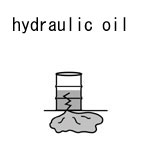| Case Name |
Leakage of hydraulic oil of an agitator caused due to increase in reaction fluid viscosity from contamination of a catalyst in a polystyrene polymerization reactor |
| Pictograph |

|
| Date |
December 24, 1998 |
| Place |
Kawasaki, Kanagawa, Japan |
| Location |
Chemical factory |
| Overview |
On December 24th, 1998, during switching operation of the grade at a polystyrene manufacturing plant in Kanagawa prefecture, the temperature and pressure rose in No.1 reactor. An interlock system was actuated, monomer supply to the reactor was stopped, and pressure relief valves were opened. A small quantity of vapor from monomers and a solvent, which had released into a relief tank, leaked into the atmosphere. Inhabitants near the plant noticed a bad smell and made emergency calls. Due to contamination of a solvent by a catalyst, a polymerization reaction was accelerated excessively, and the pressure and temperature rose. As a result of the excessive reaction, viscosity of a reaction liquid became high, the agitator output rapidly and sharply increased, hydraulic oil pressure rapidly increased, and hydraulic oil leaked from a joint of hydraulic oil piping. |
| Incident |
Hydraulic oil of an agitator at a polymerization reactor leaked. At the same time, a foul smell came from a pressure relief tank, and neighbors made emergency calls. |
| Processing |
Manufacture |
| Individual Process |
Reaction |
| Chemical Reaction |
Polymerization |
| Substance |
Styrene, Fig3 |
| Acrylonitrile, Fig4 |
| Ethylbenzene, Fig5 |
| Type of Accident |
Leakage, environmental pollution |
| Sequence |
During switching operation of the grade at polystyrene manufacturing plant-2, the temperature and pressure rose in No.1 reactor. An interlock system worked and monomer supply to all reactors was stopped and pressure relief valves were opened. A small quantity of vapor from monomers and a solvent, which were released into a relief tank, leaked into the atmosphere. Nearby inhabitants noticed the smell and made emergency calls. Around that time employees on patrol noticed leakage of hydraulic oil from a joint in hydraulic oil piping of the agitator in the reactor. |
| Cause |
1. The solvent that was switched was contaminated with a very small amount of catalysts. Therefore, a polymerization reaction advanced unexpectedly rapidly, and the pressure and temperature in the reactor rose.
2. The viscosity of the contents of the reactor rapidly increased due to the rapid polymerization reaction. This resulted in overloading the motor of the agitator, and hydraulic oil pressure increased rapidly. Hydraulic oil leaked from the joint.
3. The increased temperature and pressure in the reactor activated an interlock system. The supply of raw materials was stopped and a pressure relief valve was opened. Part of vapor and gas from the monomer was released into atmosphere through the pressure relief tank. |
| Countermeasures |
1. Improving application methods of a "prior check sheet" on remodeling and changing facilities.
2. Review of criteria of the pressure and air-tightness test of a hydraulic system.
3. Review of the relief system.
4. Review of judgment criteria for abnormal reactions and emergency cooling standards, and re-training of workers. |
| Knowledge Comment |
1. Secondhand equipment may generate undesirable effects anywhere.
2. A slight odor from atmospheric emission in an emergency, which was not considered as a problem in those days at plant construction, causes concerns among neighbors in these days. Environmental pollution prevention facilities adjusted to current demands are required. |
| Background |
1. The solvent storage tank was secondhand, and it was connected to a catalyst tank of another plant with piping and the two tanks were separated by only one block valve. The catalyst was contaminated with a seat leak at the block valve. Therefore, the cause is considered to be an insufficient cut-off; in other words, the remodeling plan for secondhand equipment was inadequate.
2. Fluctuations of the reaction by contamination of a solvent with a catalyst had not been predicted. If the problem of contamination by a catalyst is predicted, separation with only one block valve and a check valve would not have been conducted. In the plan of secondhand use of the tank, pre-study of the effects on the reaction was supposed to be insufficient. |
| Incidental Discussion |
A seat leak of the valve was also a cause. There are many cases of trouble caused by a valve seat leak, especially at large rusty valves. Countermeasures against valve seat leaks should be considered, for instance, inserting a blind plate. |
| Reason for Adding to DB |
Example of mind changing of inhabitants due to the times passing |
| Scenario |
| Primary Scenario
|
Insufficient Analysis or Research, Insufficient Prior Research, Influences of diverted vessel, Organizational Problems, Inflexible Management Structure, Insufficient Information Transfer, Planning and Design, Poor Planning, Cleanng of diverted vessel, Bad Event, Chemical Phenomenon, Viscosity Increase, Failure, Fracture/Damage, Loosen of Joint Part, Secondary Damage, External Damage, Leakage
|
|
| Sources |
Kawasaki City Fire fighting station. Prevention division Peace section. Leak at hydraulic oil Polymerization reactor agitator. Material of the Kawasaki City Complex safety countermeasures committee. (1999)
|
| Physical Damage |
About 20 liters of hydraulic oil of an agitator |
| Consequences |
A small quantity of styrene monomer vapor leaked into the atmosphere and neighbors made emergency calls due to a bad smell. |
| Multimedia Files |
Fig2.Reactor schematic drawings
|
|
Fig3.Chemical formula
|
|
Fig4.Chemical formula
|
|
Fig5.Chemical formula
|
| Field |
Chemicals and Plants
|
| Author |
YOSHINAGA, Jun (Graduate School of New Frontier Sciences, The University of Tokyo)
TAMURA, Masamitsu (Center for Risk Management and Safety Sciences, Yokohama National University)
|
|